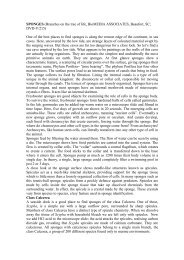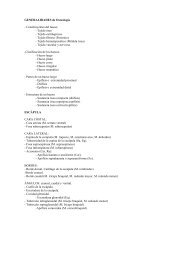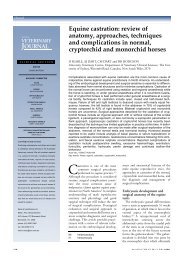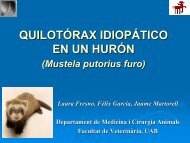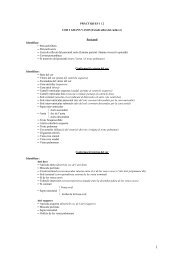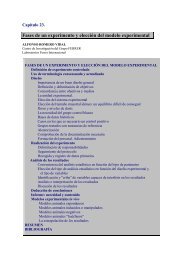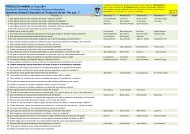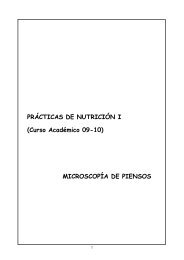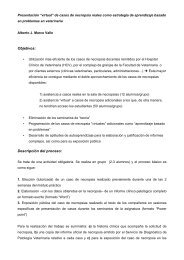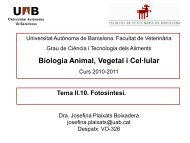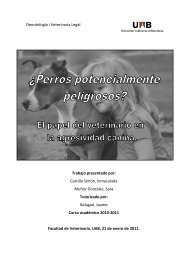Clasificación de la agresividad
Clasificación de la agresividad
Clasificación de la agresividad
You also want an ePaper? Increase the reach of your titles
YUMPU automatically turns print PDFs into web optimized ePapers that Google loves.
•<br />
•<br />
Tema<br />
<strong>C<strong>la</strong>sificación</strong><br />
7. Agresividad<br />
Factores que modifican <strong>la</strong> expresión<br />
<strong>de</strong> <strong>la</strong> conducta agresiva
•<br />
•<br />
•<br />
•<br />
<strong>C<strong>la</strong>sificación</strong><br />
Causa<br />
Ofensiva<br />
–<br />
–<br />
–<br />
–<br />
orgánica<br />
Jerárquica<br />
Por competencia<br />
Territorial – sólo<br />
Intrasexual<br />
Defensiva<br />
Depredadora<br />
–<br />
sólo<br />
especies<br />
carnívoros<br />
<strong>de</strong> <strong>la</strong> <strong>agresividad</strong><br />
territoriales<br />
(perro, gato)<br />
(perro, gato)
•<br />
•<br />
•<br />
•<br />
Agresividad<br />
orgánica<br />
con causa<br />
En todas <strong>la</strong>s especies, pero en <strong>la</strong> práctica sólo es importante en el<br />
perro y el gato<br />
En el perro<br />
Causa<br />
supone<br />
principal: dolor<br />
Otras causas<br />
aprox. 15% <strong>de</strong> todos<br />
los casos<br />
<strong>de</strong> <strong>agresividad</strong>
•<br />
•<br />
Dolor-<br />
Agresividad<br />
causa<br />
Agresividad<br />
orgánica<br />
principal: problemas<br />
en respuesta<br />
al contacto<br />
con causa<br />
articu<strong>la</strong>res<br />
o en cualquier<br />
otro contexto
•<br />
•<br />
•<br />
•<br />
<strong>C<strong>la</strong>sificación</strong><br />
Causa<br />
Ofensiva<br />
–<br />
–<br />
–<br />
–<br />
orgánica<br />
Jerárquica<br />
Por competencia<br />
Territorial – sólo<br />
Intrasexual<br />
Defensiva<br />
Depredadora<br />
–<br />
sólo<br />
especies<br />
<strong>de</strong> <strong>la</strong> <strong>agresividad</strong><br />
territoriales<br />
carnívoros (perro, gato)<br />
(perro, gato)
•<br />
•<br />
•<br />
Diferencias<br />
Postura<br />
Efecto<br />
ofensiva<br />
<strong>de</strong> <strong>la</strong>s<br />
Estructuras<br />
hormonas<br />
entre <strong>agresividad</strong><br />
y <strong>de</strong>fensiva<br />
sexuales<br />
<strong>de</strong>l SNC implicadas<br />
masculinas
•<br />
•<br />
•<br />
Diferencias<br />
Postura<br />
Efecto<br />
ofensiva<br />
<strong>de</strong> <strong>la</strong>s<br />
Estructuras<br />
hormonas<br />
entre <strong>agresividad</strong><br />
y <strong>de</strong>fensiva<br />
sexuales<br />
<strong>de</strong>l SNC implicadas<br />
masculinas
X<br />
SNC<br />
Estímulo alternativo<br />
Agresividad redirigida<br />
Respuesta<br />
R<br />
E<br />
Estímulo original<br />
E<br />
Barrera<br />
Física / Social
Agresividad redirigida en gatos<br />
Los estímulos que más frecuentemente<br />
<strong>de</strong>senca<strong>de</strong>nan un ataque son:<br />
Interacción con otro gato<br />
Visitas<br />
Sonidos <strong>de</strong> elevada frecuencia<br />
La <strong>agresividad</strong> pue<strong>de</strong> mantenerse tras el ataque<br />
(<strong>de</strong>s<strong>de</strong> 30 minutos a varias horas).<br />
La víctima suele recibir varios mordiscos y arañazos<br />
que requieren atención médica.
•<br />
•<br />
•<br />
•<br />
Factores<br />
expresión<br />
Genotipo<br />
Hormonas<br />
-<br />
Aprendizaje<br />
Serotonina<br />
¿raza?<br />
que<br />
modifican<br />
<strong>la</strong><br />
<strong>de</strong> <strong>la</strong> conducta<br />
agresiva
Diferencias entre razas<br />
Social conflict<br />
aggression<br />
Aggression<br />
towards people<br />
Overall<br />
aggression<br />
Control<br />
popu<strong>la</strong>tion<br />
Social conflict<br />
aggression<br />
Aggression<br />
towards people<br />
Overall<br />
aggression<br />
Control<br />
popu<strong>la</strong>tion<br />
0 10 20 30 40<br />
0 2 4 6 8 10<br />
Factor <strong>de</strong> riesgo<br />
9.36<br />
7.96<br />
3.69<br />
7.77<br />
6.63<br />
3.32<br />
Fatjo J, Amat M, Mariotti V, Ruiz <strong>de</strong> <strong>la</strong> Torre JL, Manteca X (2007) Analysis of 1040 cases of canine aggression in a<br />
referral practice in Spain. Journal of Veterinary Behavior: Clinical Applications and Research 2: 158-165.
Variabilidad <strong>de</strong>ntro <strong>de</strong> cada raza
•<br />
•<br />
•<br />
•<br />
Factores<br />
expresión<br />
Genotipo<br />
Hormonas<br />
-<br />
Aprendizaje<br />
Serotonina<br />
¿raza?<br />
que<br />
modifican<br />
<strong>la</strong><br />
<strong>de</strong> <strong>la</strong> conducta<br />
agresiva
Serotonina
Impulsividad<br />
Reducción o <strong>de</strong>saparción <strong>de</strong> <strong>la</strong>s señales <strong>de</strong><br />
aviso que prece<strong>de</strong>n a un episodio <strong>de</strong><br />
<strong>agresividad</strong><br />
Señales <strong>de</strong><br />
aviso<br />
Peremans K et al, 2003<br />
Impulsividad<br />
Ataque Reposo<br />
Ataque Reposo
•<br />
•<br />
•<br />
•<br />
•<br />
•<br />
Factores<br />
actividad<br />
Genotipo<br />
Dieta<br />
Ejercicio<br />
Estrés<br />
físico<br />
Enfermeda<strong>de</strong>s<br />
Fármacos<br />
que<br />
modifican<br />
<strong>la</strong><br />
<strong>de</strong> <strong>la</strong> serotonina
•<br />
•<br />
Agresividad<br />
Tipos<br />
en animales<br />
producción<br />
principales<br />
Consecuencias<br />
<strong>de</strong>
Efecto <strong>de</strong> <strong>la</strong> competencia<br />
sobre<br />
<strong>la</strong> ingestión <strong>de</strong> alimento
Tiempo en el<br />
come<strong>de</strong>ro (h)<br />
Corre<strong>la</strong>ción con <strong>la</strong><br />
jerarquía<br />
Estrés social<br />
Longitud <strong>de</strong> come<strong>de</strong>ro por animal (cm)<br />
50 40 30 20 10<br />
3.82 3.73 3.73 3.76 2.57<br />
0.46 0.32 0.30 0.67 0.71<br />
Recomendación: 60 cm / vaca
Densidad<br />
m 2 /cerdo<br />
Agresividad por competencia<br />
Nº <strong>de</strong> agresiones<br />
Efecto <strong>de</strong>l espacio<br />
Alta Media Baja<br />
0.56<br />
27.7<br />
(cerdos <strong>de</strong> 50 – 70Kg)<br />
0.77 1.19<br />
19.7 11.3
Peso (Kg)<br />
Hasta 10<br />
10 - 20<br />
20 - 30<br />
30 - 50<br />
50 - 85<br />
85 - 110<br />
más <strong>de</strong> 110<br />
Densidad en transición y cebo<br />
(directiva 91/630 CEE)<br />
Espacio mínimo / animal<br />
0.15 m 2<br />
0.20 m 2<br />
0.30 m 2<br />
0.40 m 2<br />
0.55 m 2<br />
0.65 m 2<br />
1.00 m 2
Agresividad por competencia<br />
Interacción entre espacio y temperatura<br />
0.16W0.33 0.06W0.33<br />
0.3W 0.33<br />
Área = 0.018W 0.67<br />
0.3W 0.33<br />
Área = 0.048W 0.67
PSE Carne normal DFD<br />
•Estrés poco antes<br />
<strong>de</strong>l sacrificio<br />
•Gen <strong>de</strong>l halotano<br />
•Sexo<br />
•Raza<br />
•Ayuno prolongado<br />
•Actividad física y estrés<br />
antes <strong>de</strong>l sacrificio
T2: 2 terneros por espacio <strong>de</strong> come<strong>de</strong>ro<br />
T4: 4 terneros por espacio <strong>de</strong> come<strong>de</strong>ro<br />
T8: 8 terneros por espacio <strong>de</strong> come<strong>de</strong>ro
8<br />
7<br />
6<br />
5<br />
4<br />
3<br />
2<br />
1<br />
0<br />
Porcentaje <strong>de</strong> hígados afectados<br />
Abcesos<br />
T8 T4 T2<br />
Abscesos<br />
y<br />
cicatrices<br />
Hígados <strong>de</strong>comisados




